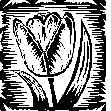 |
Plant Physiology (Biology 327) - Dr. Stephen G. Saupe; College of St. Benedict/ St. John's University; Biology Department; Collegeville, MN 56321; (320) 363 - 2782; (320) 363 - 3202, fax; ssaupe@csbsju.edu |
 |
Plant Physiology (Biology 327) - Dr. Stephen G. Saupe; College of St. Benedict/ St. John's University; Biology Department; Collegeville, MN 56321; (320) 363 - 2782; (320) 363 - 3202, fax; ssaupe@csbsju.edu |
Measuring the Water Status of Potato Tubers
Objectives: Upon completion of this laboratory you should be able to:
Introduction
Water potential (Ψw,
psi), which is a measure of the energy state of water is affected by dissolved
solutes, pressure and matrix particles. The contribution to water potential by
dissolved solutes, termed osmotic potential (Ψs
), is always negative in sign. In other words, solutes decrease the
water potential. The contribution of pressure (Ψp)
may be positive, negative or zero, but is generally positive since most plant cells are
turgid (turgor pressure). The contribution due to the binding
of water to colloidal particles (matric) and surfaces, termed matric potential (Ψm),
also lowers the water potential. Although it is often small enough to be
ignored, matrix potential is important when considering
soil water relations. Thus, the water potential of a plant system can be
arithmetically represented by the equation:
Ψw = Ψs + Ψp + Ψm
In this lab we will use the Chardakov and Gravimetric techniques to determine the water potential (Ψw) of a potato tuber cells. We will determine the solute potential (Ψs ) by the Freezing Point Depression Method. Pressure in the cells can be arithmetically calculated once Ψs and Ψw are known. If time permits, we will also measure the water conductivity of potato tubers, determine the Q10 for water transport into potatoes and prepare a Hofler diagram.
Pre-Lab:
Post-Lab Assignment
References:
Lab Documents:
| | Top | SGS Home | CSB/SJU Home | Biology Dept | Biol 327 Home | Disclaimer | |
Last updated:
01/07/2009 � Copyright by SG
Saupe